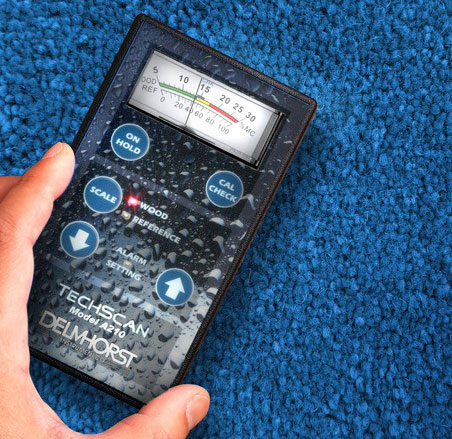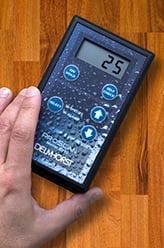 A couple of years ago, Delmhorst Instrument Co. introduced a new pinless moisture meter to our customers: the TechScan pinless meter. Since the introduction of TechScan, it has proven to be a popular choice for building inspectors and restoration contractors who work with wood and other building materials on a regular basis.
A couple of years ago, Delmhorst Instrument Co. introduced a new pinless moisture meter to our customers: the TechScan pinless meter. Since the introduction of TechScan, it has proven to be a popular choice for building inspectors and restoration contractors who work with wood and other building materials on a regular basis.
With a built-in wood scale able to measure the %MC of wood over the 5% to 30% moisture range, and a reference scale for non-wood materials, Delmhorst’s TechScan pinless moisture meter is versatile enough to tackle a variety of jobs.
Recently, Delmhorst released a new pinless-type moisture meter: ProScan.
Why the New Meter?
As a company, Delmhorst is dedicated to bringing customers the best moisture testing tools possible, and as such, constantly works to refine existing designs and create new meters using customer feedback to provide tools that meet real-world needs.
Because of this, it was only natural to make a new pinless meter to meet the needs of users.
What’s the Difference?
 So, with the question of “why” out of the way, what makes ProScan different from TechScan?
So, with the question of “why” out of the way, what makes ProScan different from TechScan?
First, we’ll start with the most obvious outward difference: the display. The display on a TechScan meter is an analog-style display, while the new ProScan meter uses a digital display. We covered the advantages of both analog and digital displays in a previous post. To summarize the contents of that post, digital displays are more precise with their readings and have more functions, while meters with analog displays tend to be easy to learn as they are often less complicated.
One of the biggest changes between the two meters that the digital display allows for is the ability to have built-in species corrections for a variety of wood species. Different kinds of wood have different specific gravities (SG), which means that if one meter were to measure a sample of oak and a sample of redwood with the same moisture content, each sample would give different readings. With built-in species corrections, it is possible to program the meter to adjust its readings based on the SG of the wood being tested. This makes ProScan ideal for flooring installers, flooring manufacturers, furniture manufacturers, and any other professional who has to work with a large variety of wood species on a daily basis.
Similarities between the Two Meters
While there are many differences between the ProScan and TechScan moisture meters, there are also a few similarities. For example, both of these pinless meters:
- Measure moisture in wood over the range of 5% to 30%.
- Have a reference scale ranging from 0 – 100 for non-wood materials.
- Are small, compact, and lightweight (8.5oz).
- Have built-in calibration checks for testing on the go.
- Are calibrated to minimize false high readings.
- Come backed by Delmhorst’s 1-year warranty.
- Both of these tools are rugged and reliable for moisture testing use.
Which is the Best?
Neither meter is better - the question really is "which meter is better for your application?"
You may prefer TechScan if you:
- Want a simple-use meter for new personnel to learn how to take moisture measurements.
- Only work with one or two different kinds of wood regularly.
- Prefer analog displays to digital ones.
On the other hand, you may find ProScan to be better for your needs if you:
- Work with a lot of different wood species.
- Need decimal-point precise readings for record-keeping purposes.
- Prefer digital displays.
Comments